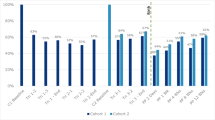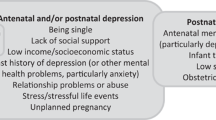Abstract
Prior studies of risk factors for depressive symptoms during pregnancy are sparse and the majority have focused on non-Hispanic white women. Hispanics are the largest minority group in the US and have the highest birth rates. We examined associations between pre and early pregnancy factors and depressive symptoms in early pregnancy among 921 participants in Proyecto Buena Salud, an ongoing cohort of pregnant Puerto Rican and Dominican women in Western Massachusetts. Depressive symptoms were assessed by the Edinburgh Postnatal Depression Scale (mean = 13 weeks gestation) by bilingual interviewers who also collected data on sociodemographic, acculturation, behavioral, and psychosocial factors. A total of 30% of participants were classified as having depressive symptoms (EPDS scores > 12) with mean + SD scores of 9.28 + 5.99. Higher levels of education (college/graduate school vs. <high school: RR = 0.60, 95% CI 0.41–0.86), household income (P trend = 0.02), and living with a spouse/partner (0.80; 95% CI 0.63–1.00) were independently associated with lower risk of depressive symptoms. There was the suggestion that failure to discontinue cigarette smoking with the onset of pregnancy (RR = 1.32; 95% CI 0.97–1.71) and English language preference (RR = 1.33; 95% CI 0.96–1.70) were associated with higher risk. Single marital status, second generation in the U.S., and higher levels of alcohol consumption were associated with higher risk of depressive symptoms in univariate analyses, but were attenuated after adjustment for other risk factors. Findings in the largest, fastest-growing ethnic minority group can inform intervention studies targeting Hispanic women at risk of depression in pregnancy.
Similar content being viewed by others
References
Gaynes, B. N., Gavin, N., Meltzer-Brody, S., et al. (2005). Perinatal depression: Prevalence, screening accuracy, and screening outcomes. Evidence report/technology assessment; 1–8.
Dayan, J., Creveuil, C., Herlicoviez, M., et al. (2002). Role of anxiety and depression in the onset of spontaneous preterm labor. American Journal of Epidemiology [serial online], 155, 293–301.
Orr, S., James, S., & Prince, C. (2002). Maternal prenatal depressive symptoms and spontaneous preterm births among African-American women in Baltimore, Maryland. American Journal of Epidemiology, 156, 797–802.
Dole, N., Savitz, D. A., Hertz-Picciotto, I., Siega-Riz, A. M., McMahon, M. J., & Buekens, P. (2003). Maternal stress and preterm birth. American Journal of Epidemiology [serial online], 157, 14–24.
Robertson, E., Grace, S., Wallington, T., & Stewart, D. (2004). Antenatal risk factors for postpartum depression: A synthesis of recent literature. General Hospital Psychiatry, 26, 289–295.
O’Hara, M. W., Stuart, S., Gorman, L. L., & Wenzel, A. (2000). Efficacy of interpersonal psychotherapy for postpartum depression. Archives of General Psychiatry, 57, 1039–1045.
Lara, M., Le, H., Letechipia, G., & Hochhausen, L. (2009). Prenatal depression in Latinas in the U.S. and Mexico. Maternal and Child Health Journal, 13, 567–576.
Rich-Edwards, J. W., Kleinman, K., Abrams, A., et al. (2006). Sociodemographic predictors of antenatal and postpartum depressive symptoms among women in a medical group practice. Journal of Epidemiology and Community Health [serial online], 60, 221–227.
Zayas, L. H., Jankowski, K. R. B., & McKee, M. D. (2003). Prenatal and postpartum depression among low-income Dominican and Puerto Rican women. Hispanic Journal of Behavioral Sciences, 25, 370–385.
Beck, C. T., Froman, R. D., & Bernal, H. (2005). Acculturation level and postpartum depression in Hispanic mothers. MCN American Journal of Maternal Child Nursing, 30, 299–304.
Potter, L. B., Rogler, L. H., & Moscicki, E. K. (1995). Depression among Puerto Ricans in New York City: The Hispanic health and nutrition examination survey. Social Psychiatry and Psychiatric Epidemiology, 30, 185.
Zambrana, R. E., & Carter-Pokras, O. (2001). Health data issues for Hispanics: Implications for public health research. Journal of Health Care for the Poor and Underserved [serial online], 12, 20–34.
Misra, D. (2001). The women’s health data book (3rd ed.). Washington, DC: Jacob’s Women’s Health Institute.
Lancaster, C., Gold, K., Flynn, H., Yoo, H., Marcus, S., & Davis, M. (2010). Risk factors for depressive symptoms during pregnancy: A systematic review. Obstetrics and Gynecology, 202, 5–14.
Holzman, C., Eyster, J., Tiedje, L., Roman, L., Seagull, E., & Rahbar, M. (2006). A life course perspective on depressive symptoms in mid-pregnancy. Maternal and Child Health Journal, 10, 127–138.
Zambrana, R. E., Scrimshaw, S. C., Collins, N., & Dunkel-Schetter, C. (1997). Prenatal health behaviors and psychosocial risk factors in pregnant women of Mexican origin: The role of acculturation. American Journal of Public Health, 87, 1022–1026.
Acevedo, M. C. (2000). The role of acculturation in explaining ethnic differences in the prenatal health-risk behaviors, mental health, and parenting beliefs of Mexican American and European American at-risk women. Child Abuse Neglect, 24, 111–127.
Chaudron, L. H. (2005). Prevalence of maternal depressive symptoms in low-income Hispanic women. The Journal of Clinical Psychiatry [serial online], 66, 418.
Kuo, W., Wilson, T., Holman, S., Fuentes-Afflick, E., O’Sullivan, M., & Minkoff, H. (2004). Depressive symptoms in the immediate postpartum period among Hispanic women in three U.S. cities. Journal of Immigrant Health, 6, 145–153.
Heilemann, M., Frutos, L., Lee, K., & Kury, F. (2004). Protective strength factors, resources, and risks in relation to depressive symptoms among childbearing women of Mexican descent. Health Care Women International, 25, 88–106.
Davila, M., McFall, S., & Cheng, D. (2009). Acculturation and depressive symptoms among pregnant and postpartum Latinas. Maternal and Child Health Journal, 13, 318–325.
Chasan-Taber, L., Fortner, R., Gollenberg, A., Buonnaccorsi, J., Dole, N., & Markenson, G. (2010). A prospective cohort study of modifiable risk factors for gestational diabetes among Hispanic women: Design and baseline characteristics. Journal of Women’s Health, 19, 117–124.
Chasan-Taber, L., Fortner, R. T., Hastings, V., & Markenson, G. (2009). Strategies for recruiting Hispanic women into a prospective cohort study of modifiable risk factors for gestational diabetes mellitus. BMC Pregnancy Childbirth, 9, 57.
Cox, J. L., Holden, J. M., & Sagovsky, R. (1987). Detection of postnatal depression. Development of the 10-item Edinburgh Postnatal Depression Scale. The British Journal of Psychiatry [serial online], 150, 782.
Jadresic, E., Araya, R., & Jara, C. (1995). Validation of the Edinburgh Postnatal Depression Scale (EPDS) in Chilean postpartum women. Journal of Psychosomatic Obstetrics and Gynaecology [serial online], 16, 187–191.
Evans, J., Heron, J., Francomb, H., Oke, S., & Golding, J. (2001). Cohort study of depressed mood during pregnancy and after childbirth. BMJ, 323, 257–260.
Yonkers, K. A., Ramin, S. M., Rush, A. J., et al. (2001). Onset and persistence of postpartum depression in an inner-city maternal health clinic system. The American Journal of Psychiatry [serial online], 158, 1856–1863.
Tropp, L. R., Erkut, S., Coll, C. G., Alarcon, O., & Vazquez Garcia, H. A. (1999). Psychological acculturation: Development of a new measure for Puerto Ricans on the U.S. mainland. Educational and Psychological Measurement, 59, 351–367.
Williams, L. M., Morrow, B., Lansky, A., et al. (2003). Surveillance for selected maternal behaviors and experiences before, during, and after pregnancy. Pregnancy risk assessment monitoring system (PRAMS), 2000. MMWR Surveill Summ, 52, 1–14.
Cohen, S., Kamarck, T., & Mermelstein, R. (1983). A global measure of perceived stress. Journal of Health and Social Behavior, 24, 385–396.
Remor, E. (2006). Psychometric properties of a European Spanish version of the Perceived Stress Scale (PSS). The Spanish Journal of Psychology [serial online], 9, 86–93.
Spielberger, C. D. (1983). Manual for the state-trait anxiety inventory. Palo Alto, CA: Consulting Psychologists Press.
Hickey, C. A., Cliver, S. P., Goldenberg, R. L., McNeal, S. F., & Hoffman, H. J. (1995). Relationship of psychosocial status to low prenatal weight gain among nonobese black and white women delivering at term. Obstetrics and Gynecology, 86, 177–183.
Spielberger, C. D., Gorsuch, R. L., & Lushene, R. E. (1986). Manual STAI. Cuestionario de Ansiedad Estado Rasgo. Adaptacion espanola.
Alder, J., Fink, N., Bitzer, J., Hsli, I., & Holzgreve, W. (2007). Depression and anxiety during pregnancy: A risk factor for obstetric, fetal and neonatal outcome? A critical review of the literature. Journal of Maternal—Fetal Neonatal Medicine, 20, 189–209.
Zhang, J., & Yu, K. F. (1998). What’s the relative risk? A method of correcting the odds ratio in cohort studies of common outcomes. JAMA, 280, 1690–1691.
Dayan, J., Creveuil, C., Marks, M. N., et al. (2006). Prenatal depression, prenatal anxiety, and spontaneous preterm birth: A prospective cohort study among women with early and regular care. Psychosomatic Medicine [serial online], 68, 938–946.
Federal Interagency Forum on Child and Family Statistics. (2007). America’s children: Key national indicators of well-being.
Ruiz, R. J., Stowe, R., Goluszko, E., Clark, M., & Tan, A. (2007). The relationships among acculturation, body mass index, depression, and interleukin 1-receptor antagonist in Hispanic pregnant women. Ethnicity Disease, 17, 338–343.
Martinez-Schallmoser, L., Telleen, S., & MacMullen, N. (2003). The effect of social support and acculturation on postpartum depression in Mexican American women. Journal of Transcultural Nursing, 14, 329–338.
Laraia, B. A., Siega-Riz, A. M., Gundersen, C., & Dole, N. (2006). Psychosocial factors and socioeconomic indicators are associated with household food insecurity among pregnant women. The Journal of Nutrition, 136, 177–182.
Wasserman, G. A., Rauh, V. A., Brunelli, S. A., Garcia-Castro, M., & Necos, B. (1990). Psychosocial attributes and life experiences of disadvantaged minority mothers: Age and ethnic variations. Child Development, 61, 566–580.
Bardwell, W. A., & Dimsdale, J. E. (2001). The impact of ethnicity and response bias on the self-report of negative affects. Journal of Applied Biobehavioral Research, 6, 27–38.
Massachusetts Department of Public Health, Bureau of Health Information, Statistics, Research, and Evaluation, Division of Research and Epidemiology. Massachusetts Births 2006. Boston, MA: Massachusetts Department of Public Health, 2008.
Acknowledgments
This work was supported by NIH NIDDK064902.
Author information
Authors and Affiliations
Corresponding author
Rights and permissions
About this article
Cite this article
Fortner, R.T., Pekow, P., Dole, N. et al. Risk Factors for Prenatal Depressive Symptoms Among Hispanic Women. Matern Child Health J 15, 1287–1295 (2011). https://doi.org/10.1007/s10995-010-0673-9
Published:
Issue Date:
DOI: https://doi.org/10.1007/s10995-010-0673-9




